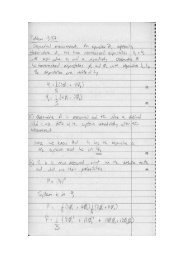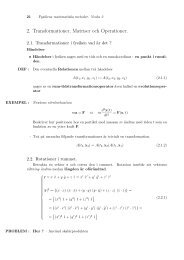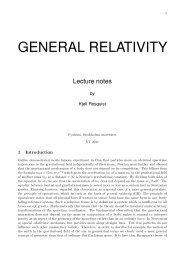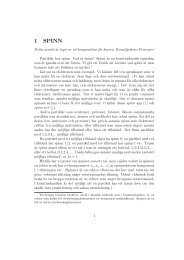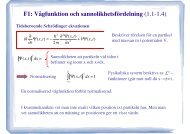Statement of research interests
Statement of research interests
Statement of research interests
You also want an ePaper? Increase the reach of your titles
YUMPU automatically turns print PDFs into web optimized ePapers that Google loves.
<strong>Statement</strong> <strong>of</strong> <strong>research</strong> <strong>interests</strong><br />
Emil Johansson Bergholtz<br />
(2007-11-21)<br />
I have a broad interest in physics in general. However, what fascinates me the most is the deep<br />
consequences <strong>of</strong> quantum mechanics. In particular I am fascinated by systems where strong<br />
correlations lead to novel phenomena. Fortunately, our universe hosts such systems and I have<br />
had the pleasure to work on a prominent and extremely rich such example: the quantum Hall<br />
effect (QHE).<br />
I want my <strong>research</strong> to be driven by interesting phenomena rather than by applying the tools I<br />
know well to an ever increasing number <strong>of</strong> problems that happens to fit. This attitude towards<br />
physics is essential to me and it keeps me evolving and learning new tools and new physics.<br />
Below, I will briefly summarize my present <strong>research</strong> and outline possible directions for my future<br />
<strong>research</strong>.<br />
Past and present <strong>research</strong><br />
My <strong>research</strong> so far has focused on the basic understanding <strong>of</strong> the (fractional) quantum Hall<br />
system. Originating from insights from a numerical project (DMRG applied to the fractional QH<br />
system), we have obtained a rather comprehensive analytical understanding <strong>of</strong> various phases<br />
present in the QH system in terms <strong>of</strong> a solvable limit <strong>of</strong> the interacting many-body problem. A<br />
single Landau level (LL) is a one-dimensional system, and on a torus there is a set <strong>of</strong> single<br />
particle states that naturally map the problem onto a 1D lattice model. We have noted that on the<br />
very thin torus this reduces to a one-dimensional classical electrostatic problem and the quantum<br />
Hall states are manifested as gapped one-dimensional crystals, Tao-Thouless (TT-) states. The<br />
fractionally charged excitations appear as domain walls between degenerate ground states, thus<br />
the emergence <strong>of</strong> such in the (2D) QH liquid is intimately connected to the analogous phenomena<br />
in (1D) polyacetylene. The TT-states represent, but are extreme forms <strong>of</strong>, the observed QH states<br />
in the bulk and their qualitative properties (such as quasiparticle charge and degeneracies,<br />
quantum numbers, relative size <strong>of</strong> the gaps, hierarchical structure, phase diagram etc.) remain the<br />
same.<br />
For the gapless states (observed at e.g. half-filling in the lowest LL), there is always a phase<br />
transition at finite thickness to phases different from the gapped TT-states. Also in this case we<br />
have been able to find an analytical solution, which is valid for half-filling on a thin, but finite<br />
torus. We have shown that this system can be mapped onto an integrable S=1/2 spin chain (in the<br />
gapless XY-phase) and the quasiparticles are identified as dipoles . This provides an explicit<br />
microscopic example <strong>of</strong> how weakly interacting quasiparticles moving in a reduced (zero)<br />
magnetic field emerge as the low energy sector <strong>of</strong> strongly interacting electrons in a strong<br />
magnetic field.<br />
The non-abelian QH states also have a simple and illuminating manifestation on the thin torus. In<br />
this case, there are several types <strong>of</strong> inequivalent groundstate configurations and the non-trivial<br />
degeneracies (that are crucial for the non-abelian statistics <strong>of</strong> the quasiparticles) are encoded in<br />
the different ways domain walls can be formed between the various groundstates. These liquids<br />
have attracted great recent interest as they are candidates as building blocks for topological<br />
quantum computers (decoherence-free computational devices), and is one <strong>of</strong> the directions we
focus on right now.<br />
We claim that for all the various states discussed above, the thin torus limit is adiabatically<br />
connected to the experimental regime in a similar manner as the free electron gas is connected to<br />
the Fermi liquids in e.g. metals (strong analytical as well as numerical support is given in our<br />
papers).<br />
During the last year we have exploited the somewhat mysterious connection between the<br />
fractional QHE and conformal field theory (CFT), that was pioneered by Moore and Read in the<br />
early 1990's. We have been able to construct explicit microscopic candidate wave functions in<br />
terms CFT correlators for a large set <strong>of</strong> states in the lowest Landau level. The wave functions<br />
obtained by our approach coincide with those due to Laughlin and Jain, whenever these exist and<br />
also yield wave functions describing other fractions. At the newly observed filling fraction, 4/11,<br />
numerics indicate that the trial wave function is indeed correct. Moreover, the Haldane-Halperin<br />
hierarchy, in which the fractionally charged quasiparticles in the vicinity <strong>of</strong> a given filling<br />
fraction condense to form a new groundstate at the new filling, is manifest in our CFT approach.<br />
Thus this provides an explicit connection between the hierarchy and composite fermion<br />
formulations <strong>of</strong> the QHE. We have also established that these wave functions coincide with the<br />
exact ones in the solvable limit (thin torus), and thus provide the adiabatic connection from this<br />
limit to the experimentally accessible regime at the pertinent fractions.<br />
The solvable limit / CFT synthesis has so far resulted in one paper (Phys. Rev. Lett., in press) and<br />
several more are in preparation. We have also published several papers focusing on the solvable<br />
limit (in Phys. Rev. Lett., Phys. Rev. B and J. Stat. Mech.). More details can be found in my CV<br />
and on my homepage: http://www.physto.se/~ejb/ .<br />
Future directions<br />
In the future I would <strong>of</strong> course like to broaden my perspectives and I see the vast and expanding<br />
area <strong>of</strong> quantum information (QI) as a very interesting direction to head towards. In particular, I<br />
am curious about systems where exotic quasiparticles emerge at low energies and their possible<br />
applications to QI. Relevant such phenomena tend to occur in low dimensional systems where<br />
effects <strong>of</strong> interaction and disorder are essential.<br />
Today, there is a lot <strong>of</strong> very interesting progress, experimental as well as theoretical, in this<br />
context. On the experimental side, significant progress is being made in several areas. With the<br />
use <strong>of</strong> optical lattices, environments that were unimaginable only a few years ago can be created.<br />
Possibly, these advances can be exploited to reach the QH regime <strong>of</strong> rotating (Bose-Einstein)<br />
condensates. Even though the particles (atoms) are predicted to be thrown out at precisely the<br />
frequencies needed to enter this regime, there is a chance that an underlying lattice may resolve<br />
these problems. Of course, if this were to be realized we would have a new experimental testing<br />
ground at our hands. Perhaps the very exotic non-abelian (parafermion) states, originally<br />
proposed as candidates for states observed in higher Landau levels in the 2D electron gas, have<br />
their best chance <strong>of</strong> existence in these systems. And <strong>of</strong> course there may be a chance for us<br />
theorists to propose new states <strong>of</strong> matter in this context. As a matter <strong>of</strong> fact, we have come across<br />
a set <strong>of</strong> interesting such states in connection to our CFT project (this is yet unpublished).<br />
As already mentioned, systems supporting non-abelian quasiparticles may arise in different<br />
contexts, most notably in the QH system and/or in rotating atomic condensates. It has been<br />
suggested that these quasiparticles can be used as qbits, thus providing the essential building<br />
blocks <strong>of</strong> a quantum computer. This suggestion has the very appealing feature that it would be
almost unaffected by decoherence, since the topological properties <strong>of</strong> these states make them<br />
insensitive to local perturbations. There is also an interesting connection to the study <strong>of</strong><br />
entanglement in topologically ordered states that connects the worlds <strong>of</strong> strongly correlated<br />
systems and QI.<br />
There is also a tremendous development when it comes to exotic materials. A few years ago<br />
graphene---a single layer <strong>of</strong> graphite---was experimentally discovered to be a stable material and<br />
has since then proven to host a number <strong>of</strong> interesting phenomena, including a new kind <strong>of</strong> QHE.<br />
Other interesting materials <strong>of</strong> current interest may support p-wave superconductivity, which in<br />
turn is intimately connected with non-abelian QH states.<br />
On the theory side, Kitaev has proposed a class <strong>of</strong> (toy) models with very interesting properties<br />
such as fractional and non-abelian statistics. It would be interesting to see if such phases can be<br />
seen in optical lattices, where interactions (at least in some sense) can be tuned by turning a nob,<br />
or perhaps in the kind <strong>of</strong> exotic materials discussed above.<br />
On a more abstract level I am very curious about why certain physical theories work as well as<br />
they do. In particular, how come that CFT plays such a prominent role in the theory <strong>of</strong> the QHE?<br />
And what is the precise connection to integrable models? I certainly feel that there are deep<br />
insights that awaits discovery regarding the connections between the FQHE, CFT and integrable<br />
models (in one-dimension). In my past (and present) <strong>research</strong> I have come across such<br />
connections, and indeed I have speculated that Haldane's conjecture for the existence <strong>of</strong> (lack <strong>of</strong>)<br />
a gap in integer (half-integer) spin chains is closely related to the (lack <strong>of</strong>) gaps at (even) odd<br />
denominator fractions in the QHE.<br />
Of course I cannot work on all <strong>of</strong> these interesting topics at once. However, to me, doing<br />
theoretical physics should be like taking a random walk in the most interesting areas. I will just<br />
try to enter this field, and hope that I stumble on the right places (and that I am educated enough<br />
to realize when it happens).



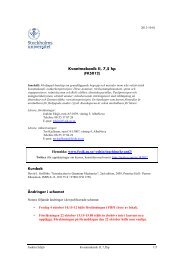
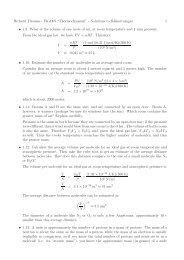
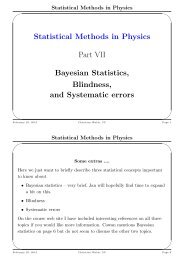
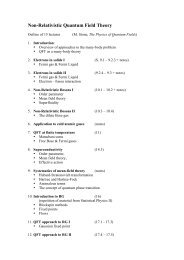
![Final Examination Paper for Electrodynamics-I [Solutions]](https://img.yumpu.com/21085948/1/184x260/final-examination-paper-for-electrodynamics-i-solutions.jpg?quality=85)

